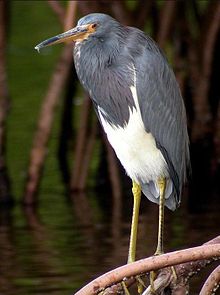Florida swamps
Appearance
This article needs additional citations for verification. (May 2015) |




Florida swamps include a variety of wetland habitats. Because of its high water table, substantial rainfall, and often flat geography, the U.S. state of Florida has a proliferation of swamp areas, some of them unique to the state.
Swamp types in Florida include:
- Cypress dome - most common swamp habitat in Florida[1]
- Strand swamp
- Floodplain swamp
- Titi swamp
- Tupelo gum swamp
- Mangrove swamp
Notable swamps
- Green Swamp (Florida) (including the Green Swamp Wilderness Preserve), Polk County
- Everglades
- Corkscrew Swamp Sanctuary in southwest Florida north of Naples, Florida
- Okefenokee Swamp, straddling the Georgia–Florida border
- Barley Barber Swamp
- Santa Fe Swamp
Animal species
Rare animals inhabiting swamps include:
- the Florida panther, an endangered subspecies of cougar (Puma concolor).
- the American alligator
Plant species
Some of the species found in the various types of swamps include:
- Cypress
- bald cypress (Taxodium distichum)
- pond cypress (Taxodium ascendens)
- red mangrove (Rhizophora mangle)
- Palms
- cabbage palm (Sabal palmetto)
- Florida royal palm (Roystonea regia)
- sawgrass (Cladium jamaicense)
- Spanish moss (Tillandsia usneoides)
In Culture
Ben Hill Griffin Stadium at Florida Field, University of Florida's football stadium is popularly known as "The Swamp". Gainesville, home of the Florida Gators, is also home to Swamp Head Brewery.
Swamp Cabbage is a swamp blues band founded by a guitarist from Jacksonville.
References
- ^ "Freshwater Swamps". SFRC Extension. University of Florida. Archived from the original on 2012-05-24. Retrieved 2012-05-21.
External links
Wikimedia Commons has media related to Swamps in Florida.
